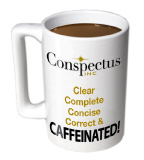The core of marketing is communication. The following quotes inspire me to be a better communicator, and offer fresh ways to think about the dynamic of marketing:
Be sincere; be brief; be seated.
- Franklin D. Roosevelt
I quote others only in order the better to express myself.
- Michel deMontaigne
If I am to speak ten minutes, I need a week for preparation; if fifteen minutes, three days; if half an hour, two days; if an hour, I am ready now.
- Woodrow Wilson
Words are, of course, the most powerful drug used by mankind.
- Rudyard Kipling
The right to be heard does not automatically include the right to be taken seriously.
- Hubert H. Humphrey
Argument is the worst sort of conversation.
- Jonathan Swift
Try the experiment of communicating, with fullness and accuracy, some experience to another, especially if it be somewhat complicated, and you will find your own attitude toward your experience changing.
- John Dewey
In describing today's accelerating changes, the media fire blips of unrelated information at us. Experts bury us under mountains of narrowly specialized monographs. Popular forecasters present lists of unrelated trends, without any model to show us their interconnections or the forces likely to reverse them. As a result, change itself comes to be seen as anarchic, even lunatic.
- Alvin Toffler
Verbosity leads to unclear, inarticulate things.
- Dan Quayle
To effectively communicate, we must realize that we are all different in the way we perceive the world and use this understanding as a guide to our communication with others.
- Tony Robbins
I know that you believe you understand what you think I said, but I'm not sure you realize that what you heard is not what I meant.
- Robert McCloskey
To listen well is as powerful a means of communication and influence as to talk well.
- John Marshall
People change and forget to tell each other.
- Lillian Hellman
Wise men talk because they have something to say; fools, because they have to say something.
- Plato
The problem with communication ... is the
illusion that it has been accomplished.
- George Bernard Shaw
Seek first to understand, then to be understood.
- Stephen Covey
Many attempts to communicate are nullified by saying too much.
- Robert Greenleaf
The colossal misunderstanding of our time is the assumption that insight will work with people who are unmotivated to change. Communication does not depend on syntax, or eloquence, or rhetoric, or articulation but on the emotional context in which the message is being heard. People can only hear you when they are moving toward you, and they are not likely to when your words are pursuing them. Even the choices words lose their power when they are used to overpower. Attitudes are the real figures of speech.
- Edwin H. Friedman
When people talk, listen completely. Most people never listen.
- Ernest Hemingway
The newest computer can merely compound, at speed, the oldest problem in the relations between human beings, and in the end the communicator will be confronted with the old problem, of what to say and how to say it.
- Edward R. Murrow
One of the basic causes for all the trouble in the world today is that people talk too much and think too little. They act impulsively without thinking. I always try to think before I talk.
- Margaret Chase Smith
Whenever two good people argue over principles, they are both right.
- Marie von Ebner-Eschenbach
The more elaborate our means of communication, the less we communicate.
- Joseph Priestley
Lying is done with words and also with silence.
- Adrienne Rich
Even if you do learn to speak correct English, whom are you going to speak it to?
- Clarence Darrow
Getting information off the Internet is like taking a drink from a fire hydrant.
- Mitchell Kapor
Communication is the real work of leadership.
- Nitin Nohria










